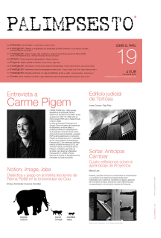Reflections on structural transparency
DOI:
https://doi.org/10.5821/palimpsesto.19.7047Keywords:
enclosure, structure, glass, transparency, tectonics.Abstract
Since ancient times until the nineteenth Century, structure plays a fundamental role in the definition of architectural space. Nevertheless, the appearance of steel for structural purposes and glass as transparent enclosure allows dissociating both functions in two different constructive systems. Modern Architecture makes this dichotomy one of its standards. At the end of the twentieth Century, the mechanical capabilities of glass were so improved that its structural application became possible. Structure and enclosure became unified again as in ancient times, although through a fully transparent element now. Structure, understood as the autonomous and clearly identified element of the Architecture of modernity, seems to be disappeared. The aim of this paper is to point out how the use of the glass as structural material affects the relation between the spatial enclosure system and the structural system that has characterized the modern architecture.Downloads
Published
Issue
Section
License
PROTECTION AND INTELLECTUAL PROPERTY CRITERIA
Authors whose work is published in en Palimpsesto agree to the following terms:
1. The author retains the copyrights and guarantees the magazine the right to apply a Creative Commons Attribution-NonCommercial-NoDerivatives (CC BY-NC-ND), which permits others to share the work with acknowledgement of authorship.
2. The author may establish additional agreements of his or her own accord for non-exclusive distribution of the article published in the magazine (for example, in an institutional repository, or published in a book).
3. Electronic distribution of the work by the author(s) is permitted and encouraged (for example, in institutional repositories or on the author’s own website), prior to, and during the submission process, as this can generate productive exchanges, as well as earlier and greater citation of the published works (see The Effect of Open Access) (in English).
4. The author or provider of the material submitted for publication authorizes Palimpsesto to publish, with no obligation whatsoever (financial or otherwise) to the content of said material, be it in paper or digital format, or in any other medium.
5. The author or provider guarantees that he or she is the owner of the Intellectual Property rights to the contents provided, which encompasses the text and images/photographs/photographic works incorporated in the article.
6. The author or provider, exempts Palimpsesto magazine of all and any responsibility relating to violation of copyrights, thereby committing himself or herself to undertaking all efforts to assist Palimpsesto magazine in defence of any accusation, extra-judiciary, and/or judicial measures. Likewise, the author or provider will assume payment to Palimpsesto of any sum or compensation that must be paid to third parties for failure to comply with these obligations, be it the result of judicial, arbitrary or administrative decisions.
7. The submission of the texts by authors implies automatically a declaration of non plagiarism of its contents







